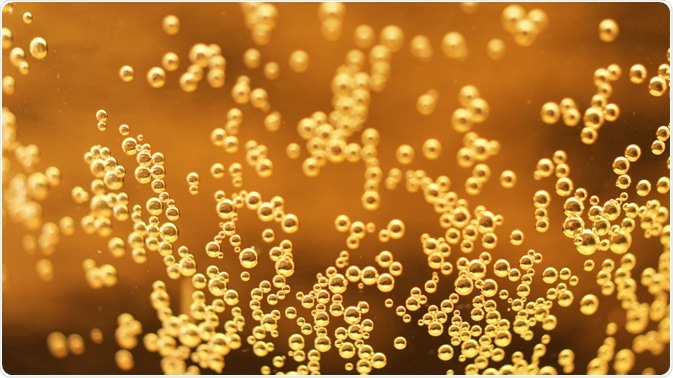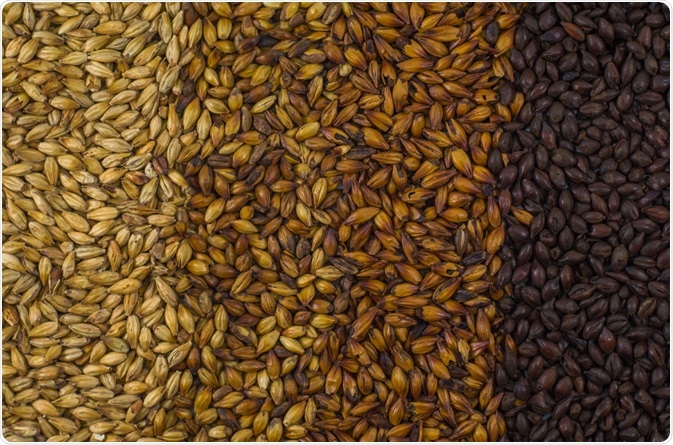Beer is the most popular fermented alcoholic beverage consumed around the world. It is brewed using barley malt, hops, and yeast, but comes in a wide array of characteristically different varieties. Lager-type beers, such as Standard American Lager and Premium American Lager, dominate the market.
In this case study, researchers examined the differences between standard and premium American lagers with 1H NMR, achieving 100% accuracy.
 Image Credit: jevgenichernov / Shutterstock.com
Image Credit: jevgenichernov / Shutterstock.com
Lagers differ mainly in terms of the types of carbohydrate sources used during brewing. Premium American Lagers are brewed with pure barley malt mixed with special malts to provide the desired specific color and flavor.
For the cheaper Standard American Lager, up to half of the base malt is replaced with an alternative carbohydrate source, or adjunct, such as corn, rice, oats, sucrose syrup.
Since malt is the main source of fermentable sugars, which are converted into ethanol, carbon dioxide, and other secondary metabolites by the yeast, the use of less costly carbohydrates requires the addition of exogenous microbial enzymes, such as amylase1.
Although using adjuncts still produces tasty high-quality lagers that are enjoyed by consumers, they are cheaper to produce and so should be marketed at lower prices than the premium lagers. For this reason, it is desirable to be able to objectively differentiate between the two types of lager.
Differentiating types of lager
Differences in the sugar composition of the beer arise from the incomplete conversion of starch, due to the malting conditions, use of adjuncts, and addition of exogenous enzymes. These characteristics are important in the development of classification models based on differences among beer styles.
However, little effort has been dedicated to the quality control and authentication of Brazilian beers, or to the differentiation of styles based on the carbohydrate sources used in the brewing process.
Many studies have focused on differentiating beers according to type and brewing process. These have largely used methodologies based on chromatography and mass spectroscopy2,3. Although these are powerful analytical techniques, they typically require some form of sample preparation. This may include several extraction, concentration, and dilution steps, and each test results in the wastage of the sample.
More recently, the authentication of foodstuffs and beverages has been successfully achieved with 1H nuclear magnetic resonance (NMR) spectroscopy4. This has the advantage of identifying and quantifying a wide range of chemical compounds in a single analysis with great precision and without the need for significant sample preparation.
Furthermore, Nuclear Magnetic Resonance spectroscopy is highly reproducible, non-destructive and allows many samples to be easily processed in a short time.
Although nuclear magnetic resonance spectroscopy has been used for the qualitative characterization of beer5, there have been no studies investigating its application for the discrimination of beers of the same type that differ only in style as a result of different carbohydrate sources being used during the brewing process.
 Four different types of barley malt. Image Credit: ThiagoSantos / Shutterstock.com
Four different types of barley malt. Image Credit: ThiagoSantos / Shutterstock.com
Using NMR to differentiate lager
Since standard American lagers have had some of the barley malt ingredients replaced with alternative carbohydrate adjuncts and required the use of exogenous enzymes, characteristic spectral variations would be expected in the carbohydrate region of their NMR fingerprint.
Researchers, therefore, decided to investigate whether these differences in NMR spectra could be used to discriminate between premium and standard American lagers.
Forty samples of Brazilian lager beer from two different classes were analyzed by 1H NMR spectroscopy combined with chemometrics6. Half of the samples were from bottles labeled as premium American lagers and the other half were standard American lagers. The NMR analysis was conducted using a Bruker Avance III HD 600 spectrometer equipped with a Triple Inverse TCI Cryo-probe head.
Principal Component Analysis revealed two clusters of components, corresponding to Premium American Lager and Standard American Lager. There was an area of overlap of the two clusters showing that the two types of lager had some common components.
It was discovered that more than 80% of the variability between the two clusters was caused by only three components. Concentrations of maltooligosaccharides and maltose were higher in the Premium American Lager style beers than in the standard American Lager style beers.
Discrimination between the different styles of beer was achieved with 100% accuracy using Partial Least Squared-Discriminant Analysis6. Application of Soft Independent Modelling of Class Analogies to the 1H NMR spectra enabled the lager beers to be differentiated with 96.4% in the calibration set and 91.6% in the prediction set.
Nuclear magnetic resonance spectroscopy along with chemometrics may thus be a powerful tool for distinguishing lager beers based on the raw materials employed in the brewing process.
References
- Holmes CP, et al. Food Chemistry 2017;221:324–334.
- Spreng S, Hofmann T. Journal of Agricultural and Food Chemistry 2018;66(3):720–731.
- Gallart-Ayala H, et al. Journal of the Institute of Brewing 2016;122(3):430–436.
- Kuballa T, et al. Current Opinion in Food Science 2018;19:57–62.
- Rodrigues JE, Gil Am. Magnetic Resonance in Chemistry 2011;49(S1):S37-45.
- Da Silva LA, et al. Food Chemistry 272 (2019) 488–493.
About Bruker BioSpin Group
The Bruker BioSpin Group designs, manufactures, and distributes advanced scientific instruments based on magnetic resonance and preclinical imaging technologies. These include our industry-leading NMR and EPR spectrometers, as well as imaging systems utilizing MRI, PET, SPECT, CT, Optical and MPI modalities. The Group also offers integrated software solutions and automation tools to support digital transformation across research and quality control environments.
Bruker BioSpin’s customers in academic, government, industrial, and pharmaceutical sectors rely on these technologies to gain detailed insights into molecular structure, dynamics, and interactions. Our solutions play a key role in structural biology, drug discovery, disease research, metabolomics, and advanced materials analysis. Recent investments in lab automation, optical imaging, and contract research services further strengthen our ability to support evolving customer needs and enable scientific innovation.
Sponsored Content Policy: News-Medical.net publishes articles and related content that may be derived from sources where we have existing commercial relationships, provided such content adds value to the core editorial ethos of News-Medical.Net which is to educate and inform site visitors interested in medical research, science, medical devices and treatments.